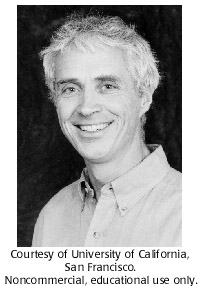Concept 34 Genes can be moved between species.


 Stan Cohen and Herb Boyer "invented" recombinant DNA technology. Doug Hanahan refined transformation methods for DNA uptake into bacteria.
Stan Cohen and Herb Boyer "invented" recombinant DNA technology. Doug Hanahan refined transformation methods for DNA uptake into bacteria.
Douglas Hanahan (1951-)

Doug Hanahan was born in Seattle, Washington. His father was a biochemist and Hanahan was exposed to the world of the "scientist" early on. He did not have any special interest in science as a child, but he did go to Massachusetts Institute of Technology and graduated with a degree in physics in 1976.
It was at M.I.T. that he first developed an interest in biology. He took a class taught by Salvatore Luria, which opened his eyes to the power of the genome. Until this class, Hanahan thought that biology was boring and involved memorizing the names of animals. He entered graduate school in the (then) Biochemistry and Molecular Biology department at Harvard University to join the biology revolution.
Although he was a Harvard graduate student, from 1979 to 1984 Hanahan spent his time at Cold Spring Harbor Laboratory (CSHL). Cohen and Boyer's recombinant DNA technology had initiated a series of discussions as to its safety, and there were strict guidelines for working with bacterial strains and recombinant DNA. CSHL was one of the facilities on the East Coast that had the type of containment facilities set up to do recombinant DNA work.
By experimentation, Hanahan was able to improve on the method used to introduce DNA into bacteria. This, and his theories on the mechanism of DNA uptake constituted the bulk of his thesis work.
Hanahan stayed at CSHL as a staff scientist until 1988. He took advantage of the small, intimate community of scientists at CSHL to explore and develop his interest in other areas of biology. Hanahan became particularly interested in oncogenes and how they worked. This is currently his main research interest.
From 1988 to 2010, Hanahan was a Professor in the Department of Biochemistry and Biophysics and Hormone Research Institute at the University of California, San Francisco. He is now director of the Swiss Institute for Experimental Cancer Research. His current research investigates the role of angiogenesis and the microenvironment in tumor development and progression, and the prospects for applying knowledge of cancer mechanisms to the development of more “targeted” therapies.
His seminal paper on the Hallmarks of Cancer, co-authored with Robert Weinberg in 2000, has become the most cited article in the prestigious journal Cell, with over 10,000 citations.
Hanahan enjoys playing tennis and sailing; both activities that he first took up while at CSHL. He also enjoys growing orchids.


Scientists recognized the potential of recombinant DNA technology for misuse, and convened a meeting in Asilomar in 1974 to discuss the implications. Some of the current guidelines for recombinant DNA research came from this early meeting.

How could recombinant DNA technology be misused?
 DNA is packaged in a chromosome.
DNA is packaged in a chromosome. Higher cells incorporate an ancient chromosome.
Higher cells incorporate an ancient chromosome. Some DNA does not encode protein.
Some DNA does not encode protein. Some DNA can jump.
Some DNA can jump. Genes can be turned on and off.
Genes can be turned on and off. Genes can be moved between species.
Genes can be moved between species. DNA responds to signals from outside the cell.
DNA responds to signals from outside the cell. Different genes are active in different kinds of cells.
Different genes are active in different kinds of cells. Master genes control basic body plans.
Master genes control basic body plans. Development balances cell growth and death.
Development balances cell growth and death. A genome is an entire set of genes.
A genome is an entire set of genes. Living things share common genes.
Living things share common genes. DNA is only the beginning for understanding the human genome.
DNA is only the beginning for understanding the human genome.